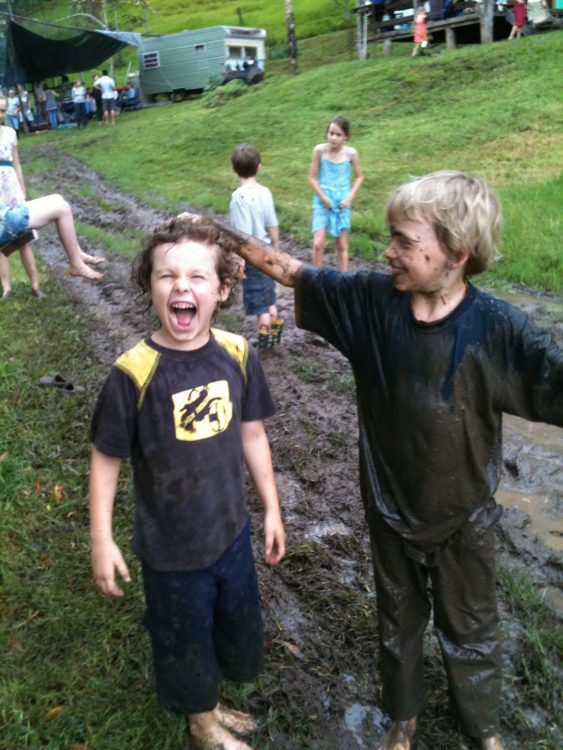Maggie in the Media, Parenting Ideas Magazine, Play & Nature Play, Posts for Parents, Press & Online
In praise of a dangerous, dirty childhood

Originally published in Parenting Ideas.
I think there is something missing from the average modern childhood. It just isn’t dangerous or dirty enough.
As a society, we’ve become risk-averse and while we worry about public liability and litigation, our children are missing out.
Definitions of risk categorise it as a situation carrying a possibility that something unpleasant, unwelcome or negative may occur. However, risk also carries the possibility of opportunity and benefit.
UK nature play advocate and author of No Fear: Growing up in a risk averse society Tim Gill has found modern playgrounds have diminished our children’s capacity to take risks.
The wooden see saw, long metal monkey bars, maypoles and a metal slide that got hot in the sun – these things may look boring compared to the colourful tempered plastic and soft-fall creations of today, but they were fantastic teachers.
The deadly seesaw
We only had to get hit in the chin by a seesaw once (OK some kids twice) to learn to stand clear when someone approached the other end. We checked the slide with our hand before subjecting our thighs to its potentially blistering surface.
We assessed the risks, and worked out that this equipment needed to be treated with respect.
Ironically, Gill’s research has found today’s children are being hurt at a higher rate in the modern safe playground than children of previous generations were in the old risky one.
Unless we allow children to stretch themselves and potentially have an accident, we’re not letting them develop competence in judging risk. This is so important later in life – risk is what we do when we launch into a new relationship, leave home to go on a holiday, take on a new job or stand up in front of a group to speak.
Modern living sees a heavy reliance on safe, supervised indoor activities often involving screens and with this comes the loss of autonomous adventuring among children.
Play rules
Play not only helps children learn about risk and decision-making, children learn nearly everything from play and it is essential for their physical, social and emotional development.
We now have children with poor eyesight, weak shoulder girdles, weak wrists and poor grip for lack of climbing. I have also seen many children with depression-like symptoms from endlessly sitting in front of screens.
Vigorous, rough and tumble play helps children, especially boys, diffuse their excess emotional energy and brings them into a calm state. Research has shown a strong link between lack of rough and tumble play and violence once boys reach adolescence.
Children also need play for brain development the cerebellum is stimulated by tumbling, rolling, balancing and spinning. These are all activities that a group of children playing in a natural environment or well-designed playground will do, without needing guidance.
So much of this is about letting our children be, letting them get dirty and suffer the odd splinter, letting them explore and connect with nature because disconnection from our natural world and from other children comes at a great price.
I am convinced the increasing violence and bullying in our schools is because we have not valued play enough. One study in the US on the adolescent boys who perpetrated mass shootings in high schools in the early 1990s identified they all had been ignored as children and had very little play.
Nature play
More councils and schools worldwide are switching on to the fact we need to go back to nature to create play environments that are highly interactive, physically engaging, and mentally and socially stimulating.
Not only do interesting, nature-based playgrounds engage children more than the modern plastic playgrounds, they encourage children to play with other children for longer periods of time and in more creative ways.
Free play stimulates children’s curiosity, absorbed interest and sustained motivation to achieve goals it builds the seeking mechanism that helps us find our way through challenges.
Children need opportunities for creative, exploratory play in stress-free environments, without restrictions on time or freedom.
I worry that the way education has gone in this country is stealing this away from our children, with the National Curriculum’s firm focus on formal learning for four-year-olds. That means instead of spending valuable time doing all of the things described above, these children are learning to read and write (oh well, I guess the most important thing is doing well on the NAPLAN right? Wrong!)
As parents, we need to steal back a few things for our children that most of us were allowed in our childhoods – a little danger, a lot of dirt and plenty of time to play like their lives depend on it.
Image supplied by Carmen Myler – with permission




 Manage Membership
Manage Membership